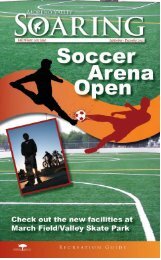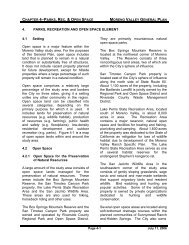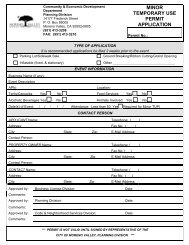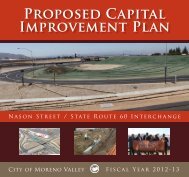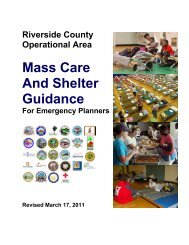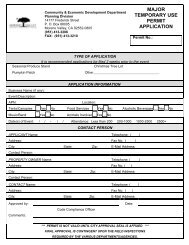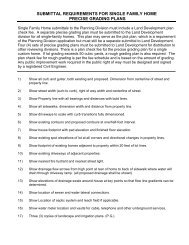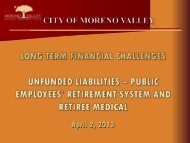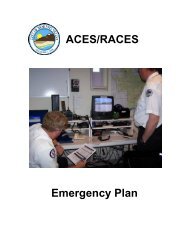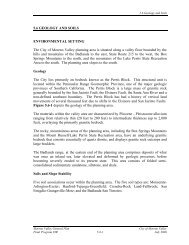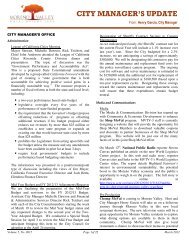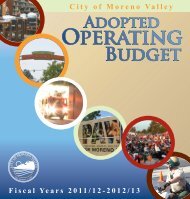General Plan - Moreno Valley
General Plan - Moreno Valley
General Plan - Moreno Valley
Create successful ePaper yourself
Turn your PDF publications into a flip-book with our unique Google optimized e-Paper software.
CHAPTER 5 – CIRCULATIONMORENO VALLEY GENERAL PLANnorth-south roadways in the vicinity of StateRoute 60 have geometric constraints thatwill prevent Level of Service "C" from beingachieved. In other cases, peak hourintersection traffic may operate at Level ofService "D" due to high employmentconcentrations.The City of <strong>Moreno</strong> <strong>Valley</strong> roadway networkcurrently meets the City Level of Servicestandards of “C” or “D”, with the exceptionof a limited number of segments. Thesegments that do not meet the standardsare primarily located on Perris Boulevard,Cactus Avenue and Frederick Street/PigeonPass Road in the vicinity of State Route 60.Subsequent segment studies will beperformed to determine additionalimprovements necessary to maintain anacceptable Level of Service at <strong>General</strong> <strong>Plan</strong>buildout.TABLE 5-1LEVEL OF SERVICE DESCRIPTIONSLOSABCDETraffic Flow ConditionsFree flow. Individual users are virtually unaffected by the presence of others in thetraffic stream. Freedom to select desired speeds and to maneuver within the trafficstream is extremely high. The general level of comfort and convenience providedto the motorist, passenger, or pedestrian is excellent.Stable flow, but the presence of other users in the traffic stream begins to benoticeable. Freedom to select desired speeds is relatively unaffected, but there is aslight decline in the freedom to maneuver within the traffic stream from LOS A.The level of comfort and convenience provided is somewhat less than at LOS A,because the presence of others in the traffic stream begins to affect individualbehavior.Stable flow, but marks the beginning of the range of flow in which the operation ofindividual users becomes significantly affected by interactions with others in thetraffic stream. The selection of speed is affected by the presence of others, andmaneuvering within the traffic stream requires substantial vigilance on the part ofthe user. The general level of comfort and convenience declines noticeably at thislevel.High-density, but stable, flow. Speed and freedom to maneuver are severelyrestricted, and the driver or pedestrian experiences a generally poor level ofcomfort and convenience. Small increases in traffic flow will generally causeoperational problems at this level.Operating conditions at or near the capacity level. All speeds are reduced to a lowbut relatively uniform value. Freedom to maneuver within the traffic stream isextremely difficult, and it is generally accomplished by forcing a vehicle orpedestrian to "give way" to accommodate such maneuvers. Comfort andconvenience levels are extremely poor, and driver or pedestrian frustration isgenerally high. Operations at this level are usually unstable, because small increasesin flow or minor perturbations within the traffic stream will cause breakdowns.FLevel-of-Service F. Forced or breakdown flow. This condition exists wherever theamount of traffic approaching a point exceeds the amount, which can traverse thepoint. Queues form behind such locations. Arrival flow exceeds discharge flow.Source: 2000 Highway Capacity Manual (HCM) (Transportation Research Board Special Report 209)Page 5-5 July 11, 2006



